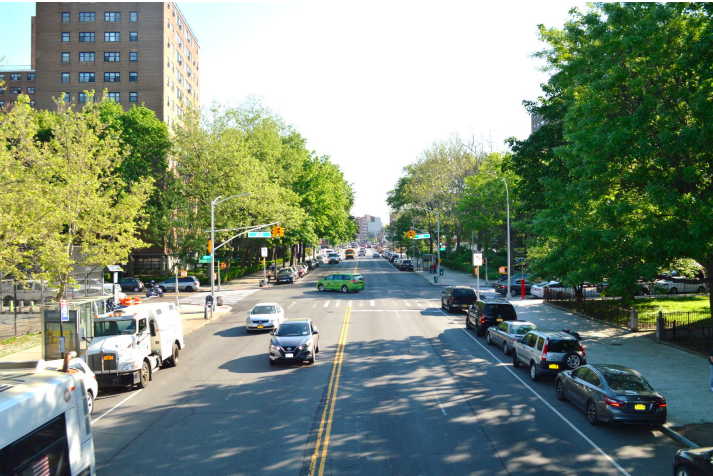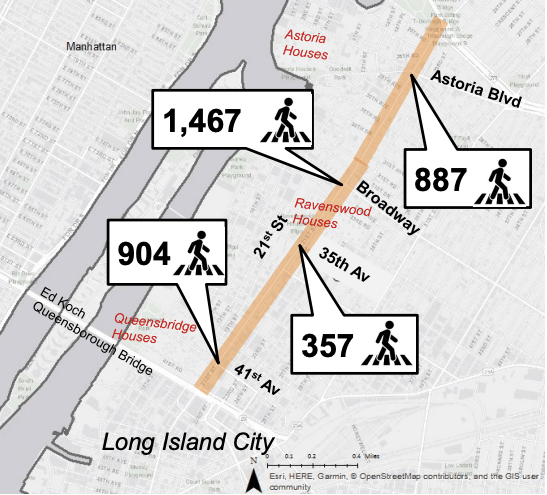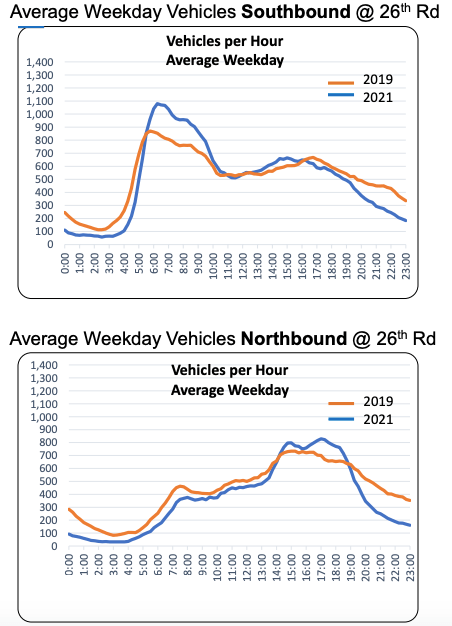
A city plan to redesign a deadly and congested Queens corridor does not go far enough to improve safety for vulnerable road users, or speed up the beleaguered buses that traverse its route, locals say.
The Department of Transportation is rolling out a redesign of 21st Street in Astoria, which runs about two miles between the Queensboro and Triboro bridges, where there's currently two lanes in each direction and curbside parking. But due to a lack of curbside regulations, derelict vehicles, and illegal parking, buses get bogged down behind private cars and the thoroughfare is notoriously dangerous — three pedestrians have been killed, and dozens more injured — most by drivers making left turns — since 2015, making it a Vision Zero Priority Corridor, according to DOT.
Yet on Monday, DOT revealed a plan — creating a dedicated curbside bus lane without removing any parking spots — that does more to protect car-owners and their free parking spaces than it does to support straphangers and pedestrians, critics said during a virtual meeting.
“For a project that’s pedestrian-safety and bus-speed-oriented, this proposal has multiple disappointing aspects,” said Adam Fisher-Cox, who lives along 21st Street.
DOT reps said they considered three options for the 60-foot wide corridor. The first option, "Queue Jump Lanes and Signals," includes giving buses a "green light" before other traffic, and their own short lane to pass other traffic stuck at the light. It would maintain the same number of travel lanes and eliminate some parking spaces.
The second option, "Offset Bus Lanes with Bus Bulbs," includes giving buses their own dedicated lane, and installing bus bulbs and curb extensions. It would keep the same amount of parking.
And the third option, "Center Running Bus Lane with Bus Stop Islands," also includes giving buses their own lane, but in the center to avoid double-parked vehicles, and building out bus stop islands. It would eliminate some parking spaces, according to the DOT presentation, which did not specify how many.
All three plans are below:
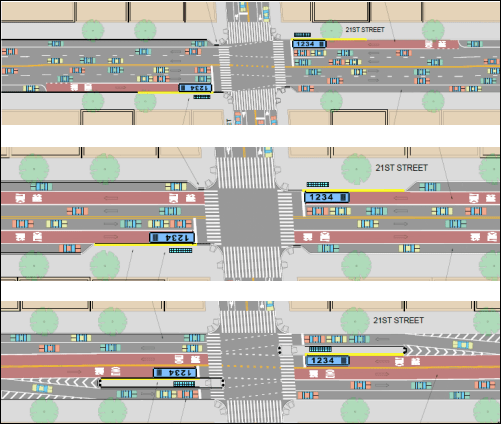
Both the Community Advisory Board, and those surveyed by DOT, preferred the third option — the center-running bus lane — because they said it would do the most to speed up buses and improve safety. Such a design would require the most parking to be converted for bus use. As expected, drivers said they preferred the second option which preserves the same number of parking spaces.
And that's whom the city listened to.

The DOT said Monday it will move ahead with the second option for 21st Street — offset bus lanes with bus bulbs — which locals argued preserves parking at the expense of pedestrians and bus riders. Several people during the meeting suggested DOT remove parking to make room for buses to pass.
“The intersection with Astoria Boulevard is a total mess, so many children cross there, it’s really dangerous. I don’t have any faith that there’s not going to be buses stuck behind people trying to turn right. I would support more physical blocks, whatever you can do to keep cars out of the lanes,” said Gordon Watt, who lives on 21st Street at Astoria Boulevard.

A rep for DOT said during the meeting that center-running bus lanes were not feasible along 21st Street given its narrowness, and that it would look at the idea of eliminating parking at the curb, including the possibility of installing meters and loading zones. It's unclear why DOT would present an option that advocates say is better, but already decided not to go with.
"[We're] not against center-running bus lanes — in principle they’re great — but we haven't been able to figure out a way to make it work. Happy to continue exploring them," said DOT project manager Chris Hrones.
And the decision was a particularly big blow to pedestrians, given that they exceed the number of cars — DOT counted more than 1,400 pedestrians in a single hour at the intersection of Broadway and 21st in 2019, nearly 400 more than the highest number of southbound vehicles logged during peak morning rush hour at 26th Road.
And even more disappointing was that the results of DOT’s public engagement processes — including pop-up surveys along the corridor and soliciting comments — revealed that the majority of locals want a safer 21st Street and faster bus service, but won't get it. Three in five people, or 63 percent, cited pedestrian safety as their biggest concern on 21st Street; 51 percent said slow or unreliable buses, 39 percent said double parking and parking on sidewalks, and only 22 percent cited parking availability as their main concern. Less than 40 percent of residents that live in the three zip codes that make up the corridor — an average of 35 percent — have at least one car available, Streetsblog has previously reported using U.S. Census Bureau data.
A DOT rep said the plan to move forward with offset bus lanes is just a jumping off point — the city is also looking at other improvements for the corridor, including loading zones and sidewalk tree plantings, and plans for bus lane and roadside cameras.
And in addition to the bus lanes, DOT is also proposing to install bus boarders at three locations: at 41st Avenue (northbound), at 35th Avenue (northbound and southbound), and at 30th Avenue (southbound); and pedestrian islands at just five locations: at 41st Avenue, at 40th Avenue (north side), at Broadway (south and north sides), at 30th Avenue (north side), and at Astoria Blvd (west and north sides), according to the presentation.
DOT says it is still soliciting feedback, and plans to present to the local community board next year, with the hope of starting work some time in 2022. And as for the criticism that the project doesn't go far enough, a spokesperson said the city had to balance changes to the corridor with it being a truck route, but that the improvements will still help nearly 30,000 daily riders.
The agency defended the process and the plan.
"This project will bring transformative upgrades to one of our Vision Zero Priority Corridors — by delivering faster commutes for nearly 30,000 daily bus riders and increasing safety for pedestrians in the area," said Vin Barone.
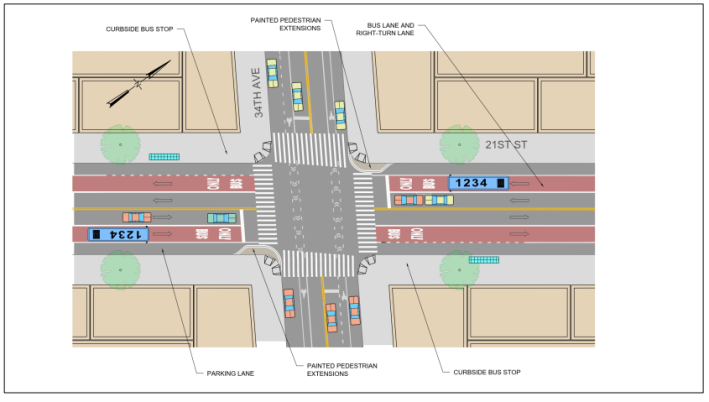
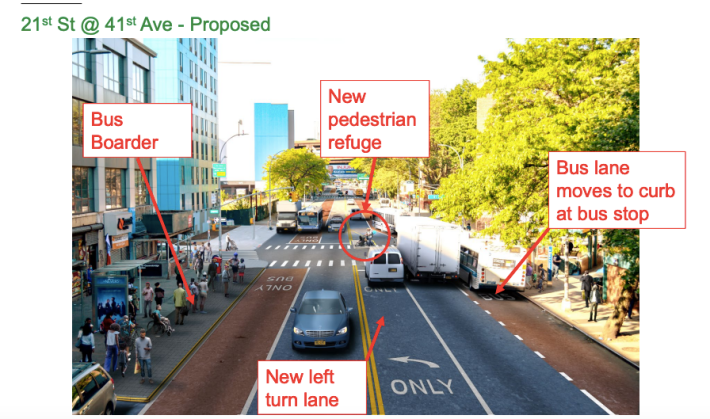
DOT will hold a second virtual meeting on Jan. 12 at 6 p.m. Register by clicking here, or provide additional comments to John O’Neill at joneill@dot.nyc.gov.
